Problem Solving and Decision Making: Frank's Case Study Analysis
VerifiedAdded on 2023/04/24
|11
|3206
|442
Report
AI Summary
This report analyzes the case study of Frank, exploring his decision-making process and problem-solving strategies within a business context. The analysis begins by categorizing Frank's problem as a 'bounded problem' and discusses how he was able to address it by implementing systematic methods, including defining the problem, analyzing its causes, and formulating solutions. The report then delves into the decision-making framework, emphasizing the importance of evaluating choices, assessing risks, and establishing criteria for solutions. Frank's approach to reducing costs and improving productivity is examined, highlighting his use of the three C's: Choices, Criteria, and Constraints. The report underscores the significance of effective decision-making in organizational growth, emphasizing the need for managers to be adaptable and strategic in their approach. It concludes by recognizing the development of an action plan as essential to implementing future decisions and solving business problems. The case study emphasizes the need for systematic approaches in business problem-solving and decision-making.
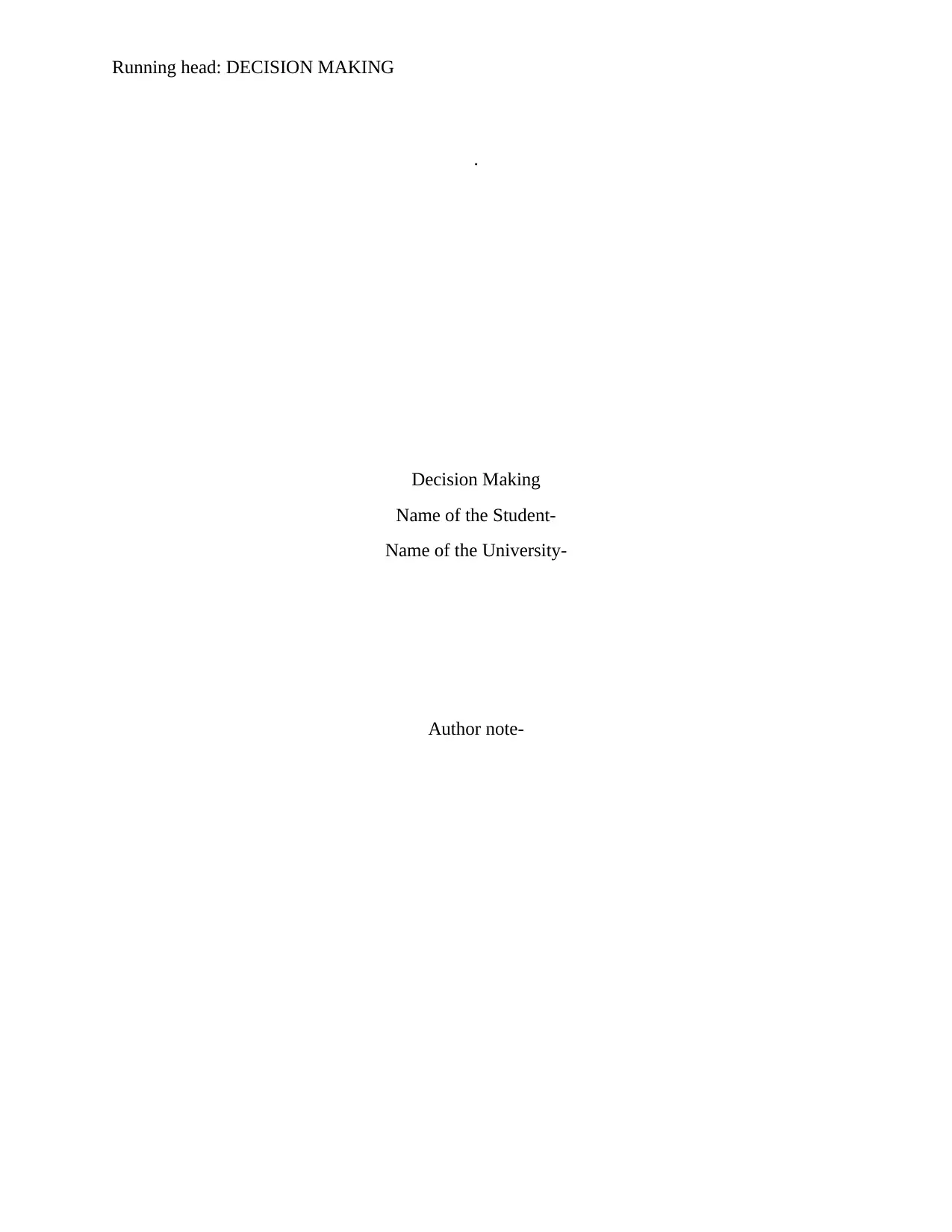
Running head: DECISION MAKING
.
Decision Making
Name of the Student-
Name of the University-
Author note-
.
Decision Making
Name of the Student-
Name of the University-
Author note-
Secure Best Marks with AI Grader
Need help grading? Try our AI Grader for instant feedback on your assignments.
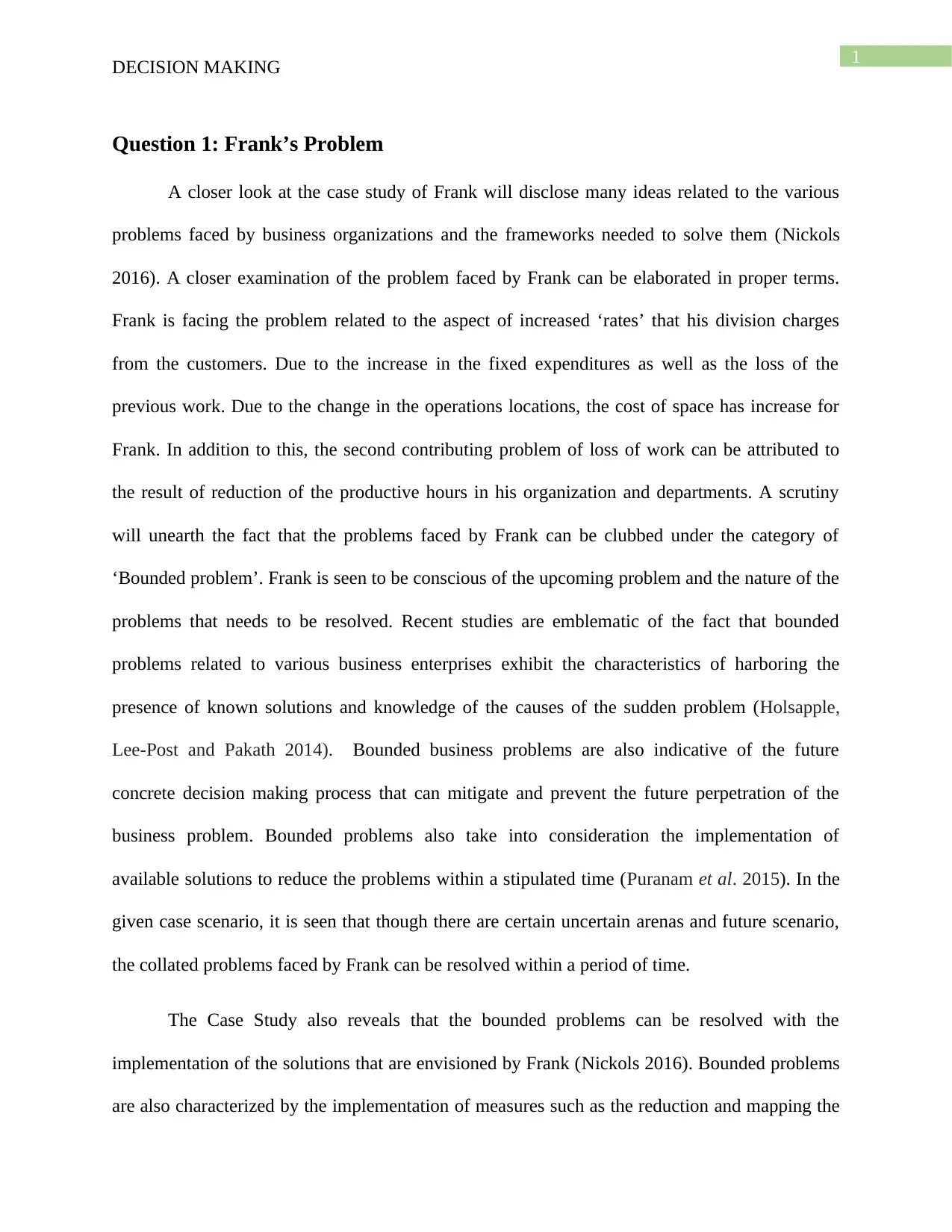
1
DECISION MAKING
Question 1: Frank’s Problem
A closer look at the case study of Frank will disclose many ideas related to the various
problems faced by business organizations and the frameworks needed to solve them (Nickols
2016). A closer examination of the problem faced by Frank can be elaborated in proper terms.
Frank is facing the problem related to the aspect of increased ‘rates’ that his division charges
from the customers. Due to the increase in the fixed expenditures as well as the loss of the
previous work. Due to the change in the operations locations, the cost of space has increase for
Frank. In addition to this, the second contributing problem of loss of work can be attributed to
the result of reduction of the productive hours in his organization and departments. A scrutiny
will unearth the fact that the problems faced by Frank can be clubbed under the category of
‘Bounded problem’. Frank is seen to be conscious of the upcoming problem and the nature of the
problems that needs to be resolved. Recent studies are emblematic of the fact that bounded
problems related to various business enterprises exhibit the characteristics of harboring the
presence of known solutions and knowledge of the causes of the sudden problem (Holsapple,
Lee-Post and Pakath 2014). Bounded business problems are also indicative of the future
concrete decision making process that can mitigate and prevent the future perpetration of the
business problem. Bounded problems also take into consideration the implementation of
available solutions to reduce the problems within a stipulated time (Puranam et al. 2015). In the
given case scenario, it is seen that though there are certain uncertain arenas and future scenario,
the collated problems faced by Frank can be resolved within a period of time.
The Case Study also reveals that the bounded problems can be resolved with the
implementation of the solutions that are envisioned by Frank (Nickols 2016). Bounded problems
are also characterized by the implementation of measures such as the reduction and mapping the
DECISION MAKING
Question 1: Frank’s Problem
A closer look at the case study of Frank will disclose many ideas related to the various
problems faced by business organizations and the frameworks needed to solve them (Nickols
2016). A closer examination of the problem faced by Frank can be elaborated in proper terms.
Frank is facing the problem related to the aspect of increased ‘rates’ that his division charges
from the customers. Due to the increase in the fixed expenditures as well as the loss of the
previous work. Due to the change in the operations locations, the cost of space has increase for
Frank. In addition to this, the second contributing problem of loss of work can be attributed to
the result of reduction of the productive hours in his organization and departments. A scrutiny
will unearth the fact that the problems faced by Frank can be clubbed under the category of
‘Bounded problem’. Frank is seen to be conscious of the upcoming problem and the nature of the
problems that needs to be resolved. Recent studies are emblematic of the fact that bounded
problems related to various business enterprises exhibit the characteristics of harboring the
presence of known solutions and knowledge of the causes of the sudden problem (Holsapple,
Lee-Post and Pakath 2014). Bounded business problems are also indicative of the future
concrete decision making process that can mitigate and prevent the future perpetration of the
business problem. Bounded problems also take into consideration the implementation of
available solutions to reduce the problems within a stipulated time (Puranam et al. 2015). In the
given case scenario, it is seen that though there are certain uncertain arenas and future scenario,
the collated problems faced by Frank can be resolved within a period of time.
The Case Study also reveals that the bounded problems can be resolved with the
implementation of the solutions that are envisioned by Frank (Nickols 2016). Bounded problems
are also characterized by the implementation of measures such as the reduction and mapping the
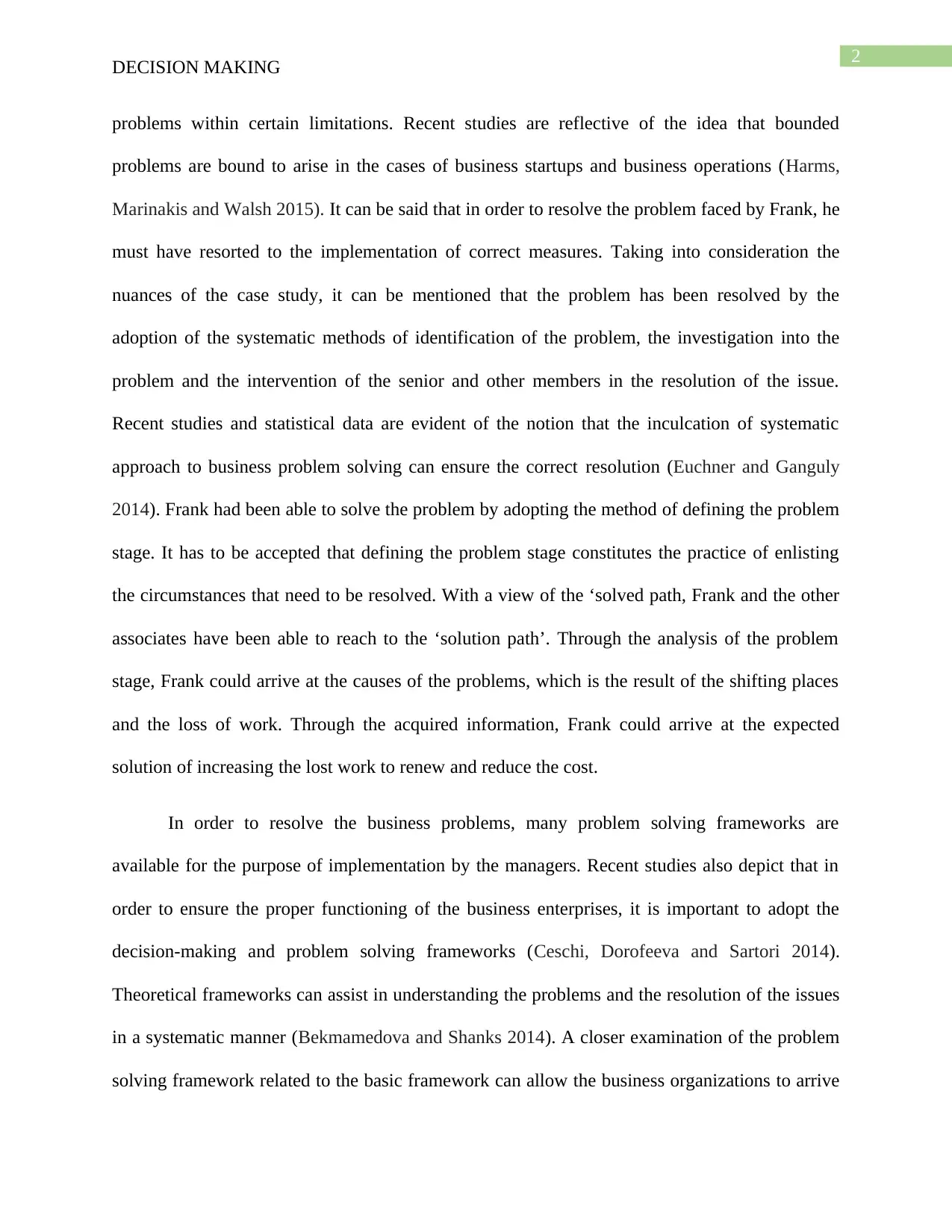
2
DECISION MAKING
problems within certain limitations. Recent studies are reflective of the idea that bounded
problems are bound to arise in the cases of business startups and business operations (Harms,
Marinakis and Walsh 2015). It can be said that in order to resolve the problem faced by Frank, he
must have resorted to the implementation of correct measures. Taking into consideration the
nuances of the case study, it can be mentioned that the problem has been resolved by the
adoption of the systematic methods of identification of the problem, the investigation into the
problem and the intervention of the senior and other members in the resolution of the issue.
Recent studies and statistical data are evident of the notion that the inculcation of systematic
approach to business problem solving can ensure the correct resolution (Euchner and Ganguly
2014). Frank had been able to solve the problem by adopting the method of defining the problem
stage. It has to be accepted that defining the problem stage constitutes the practice of enlisting
the circumstances that need to be resolved. With a view of the ‘solved path, Frank and the other
associates have been able to reach to the ‘solution path’. Through the analysis of the problem
stage, Frank could arrive at the causes of the problems, which is the result of the shifting places
and the loss of work. Through the acquired information, Frank could arrive at the expected
solution of increasing the lost work to renew and reduce the cost.
In order to resolve the business problems, many problem solving frameworks are
available for the purpose of implementation by the managers. Recent studies also depict that in
order to ensure the proper functioning of the business enterprises, it is important to adopt the
decision-making and problem solving frameworks (Ceschi, Dorofeeva and Sartori 2014).
Theoretical frameworks can assist in understanding the problems and the resolution of the issues
in a systematic manner (Bekmamedova and Shanks 2014). A closer examination of the problem
solving framework related to the basic framework can allow the business organizations to arrive
DECISION MAKING
problems within certain limitations. Recent studies are reflective of the idea that bounded
problems are bound to arise in the cases of business startups and business operations (Harms,
Marinakis and Walsh 2015). It can be said that in order to resolve the problem faced by Frank, he
must have resorted to the implementation of correct measures. Taking into consideration the
nuances of the case study, it can be mentioned that the problem has been resolved by the
adoption of the systematic methods of identification of the problem, the investigation into the
problem and the intervention of the senior and other members in the resolution of the issue.
Recent studies and statistical data are evident of the notion that the inculcation of systematic
approach to business problem solving can ensure the correct resolution (Euchner and Ganguly
2014). Frank had been able to solve the problem by adopting the method of defining the problem
stage. It has to be accepted that defining the problem stage constitutes the practice of enlisting
the circumstances that need to be resolved. With a view of the ‘solved path, Frank and the other
associates have been able to reach to the ‘solution path’. Through the analysis of the problem
stage, Frank could arrive at the causes of the problems, which is the result of the shifting places
and the loss of work. Through the acquired information, Frank could arrive at the expected
solution of increasing the lost work to renew and reduce the cost.
In order to resolve the business problems, many problem solving frameworks are
available for the purpose of implementation by the managers. Recent studies also depict that in
order to ensure the proper functioning of the business enterprises, it is important to adopt the
decision-making and problem solving frameworks (Ceschi, Dorofeeva and Sartori 2014).
Theoretical frameworks can assist in understanding the problems and the resolution of the issues
in a systematic manner (Bekmamedova and Shanks 2014). A closer examination of the problem
solving framework related to the basic framework can allow the business organizations to arrive
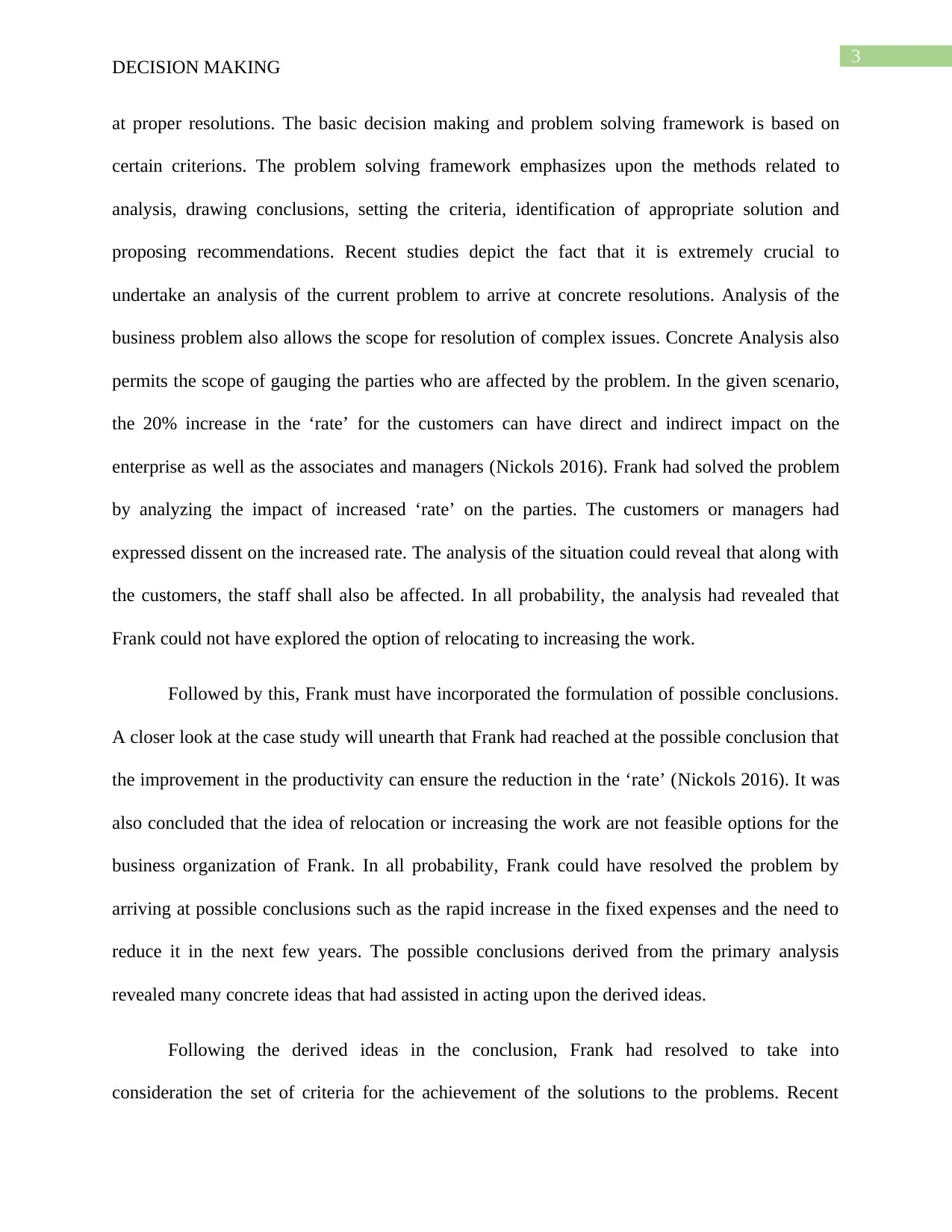
3
DECISION MAKING
at proper resolutions. The basic decision making and problem solving framework is based on
certain criterions. The problem solving framework emphasizes upon the methods related to
analysis, drawing conclusions, setting the criteria, identification of appropriate solution and
proposing recommendations. Recent studies depict the fact that it is extremely crucial to
undertake an analysis of the current problem to arrive at concrete resolutions. Analysis of the
business problem also allows the scope for resolution of complex issues. Concrete Analysis also
permits the scope of gauging the parties who are affected by the problem. In the given scenario,
the 20% increase in the ‘rate’ for the customers can have direct and indirect impact on the
enterprise as well as the associates and managers (Nickols 2016). Frank had solved the problem
by analyzing the impact of increased ‘rate’ on the parties. The customers or managers had
expressed dissent on the increased rate. The analysis of the situation could reveal that along with
the customers, the staff shall also be affected. In all probability, the analysis had revealed that
Frank could not have explored the option of relocating to increasing the work.
Followed by this, Frank must have incorporated the formulation of possible conclusions.
A closer look at the case study will unearth that Frank had reached at the possible conclusion that
the improvement in the productivity can ensure the reduction in the ‘rate’ (Nickols 2016). It was
also concluded that the idea of relocation or increasing the work are not feasible options for the
business organization of Frank. In all probability, Frank could have resolved the problem by
arriving at possible conclusions such as the rapid increase in the fixed expenses and the need to
reduce it in the next few years. The possible conclusions derived from the primary analysis
revealed many concrete ideas that had assisted in acting upon the derived ideas.
Following the derived ideas in the conclusion, Frank had resolved to take into
consideration the set of criteria for the achievement of the solutions to the problems. Recent
DECISION MAKING
at proper resolutions. The basic decision making and problem solving framework is based on
certain criterions. The problem solving framework emphasizes upon the methods related to
analysis, drawing conclusions, setting the criteria, identification of appropriate solution and
proposing recommendations. Recent studies depict the fact that it is extremely crucial to
undertake an analysis of the current problem to arrive at concrete resolutions. Analysis of the
business problem also allows the scope for resolution of complex issues. Concrete Analysis also
permits the scope of gauging the parties who are affected by the problem. In the given scenario,
the 20% increase in the ‘rate’ for the customers can have direct and indirect impact on the
enterprise as well as the associates and managers (Nickols 2016). Frank had solved the problem
by analyzing the impact of increased ‘rate’ on the parties. The customers or managers had
expressed dissent on the increased rate. The analysis of the situation could reveal that along with
the customers, the staff shall also be affected. In all probability, the analysis had revealed that
Frank could not have explored the option of relocating to increasing the work.
Followed by this, Frank must have incorporated the formulation of possible conclusions.
A closer look at the case study will unearth that Frank had reached at the possible conclusion that
the improvement in the productivity can ensure the reduction in the ‘rate’ (Nickols 2016). It was
also concluded that the idea of relocation or increasing the work are not feasible options for the
business organization of Frank. In all probability, Frank could have resolved the problem by
arriving at possible conclusions such as the rapid increase in the fixed expenses and the need to
reduce it in the next few years. The possible conclusions derived from the primary analysis
revealed many concrete ideas that had assisted in acting upon the derived ideas.
Following the derived ideas in the conclusion, Frank had resolved to take into
consideration the set of criteria for the achievement of the solutions to the problems. Recent
Secure Best Marks with AI Grader
Need help grading? Try our AI Grader for instant feedback on your assignments.
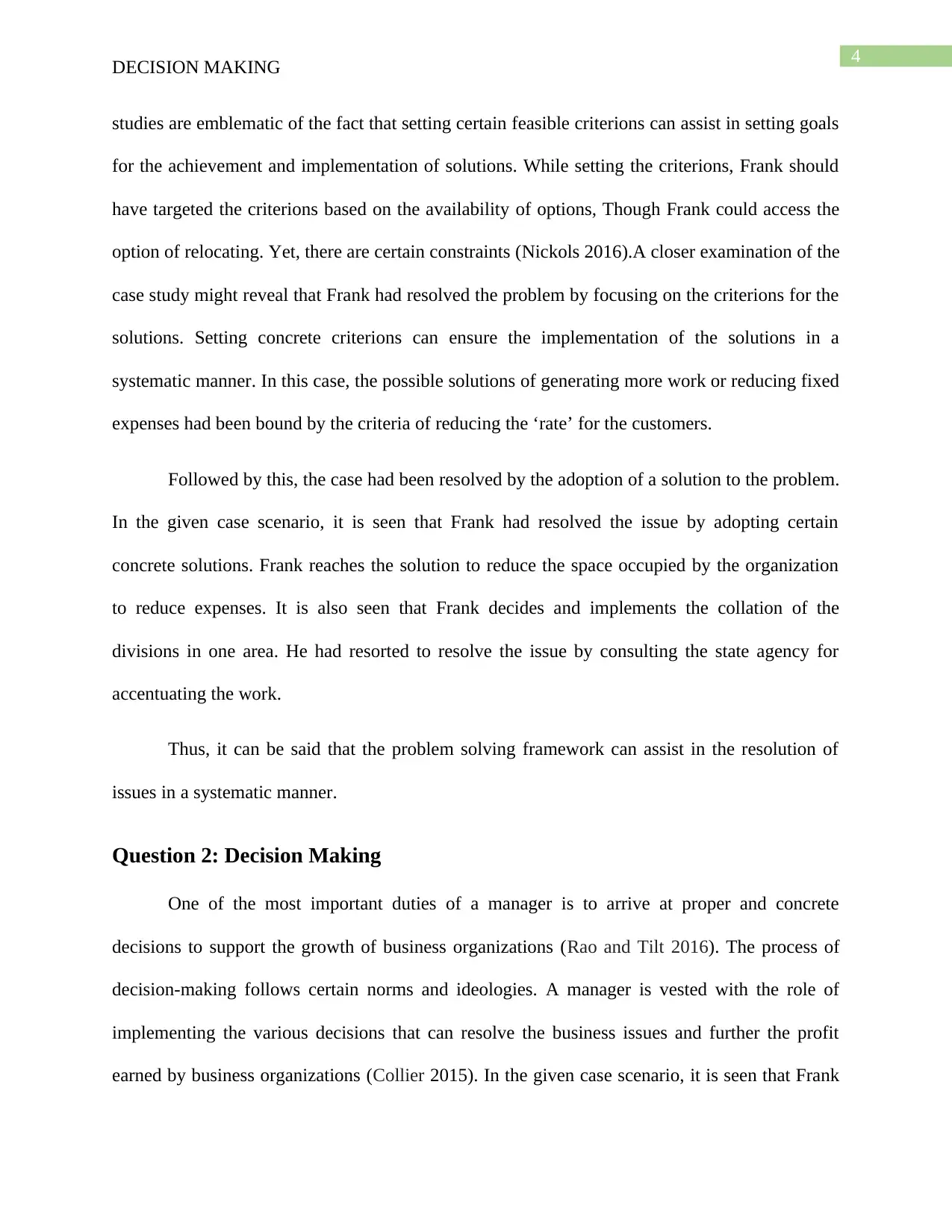
4
DECISION MAKING
studies are emblematic of the fact that setting certain feasible criterions can assist in setting goals
for the achievement and implementation of solutions. While setting the criterions, Frank should
have targeted the criterions based on the availability of options, Though Frank could access the
option of relocating. Yet, there are certain constraints (Nickols 2016).A closer examination of the
case study might reveal that Frank had resolved the problem by focusing on the criterions for the
solutions. Setting concrete criterions can ensure the implementation of the solutions in a
systematic manner. In this case, the possible solutions of generating more work or reducing fixed
expenses had been bound by the criteria of reducing the ‘rate’ for the customers.
Followed by this, the case had been resolved by the adoption of a solution to the problem.
In the given case scenario, it is seen that Frank had resolved the issue by adopting certain
concrete solutions. Frank reaches the solution to reduce the space occupied by the organization
to reduce expenses. It is also seen that Frank decides and implements the collation of the
divisions in one area. He had resorted to resolve the issue by consulting the state agency for
accentuating the work.
Thus, it can be said that the problem solving framework can assist in the resolution of
issues in a systematic manner.
Question 2: Decision Making
One of the most important duties of a manager is to arrive at proper and concrete
decisions to support the growth of business organizations (Rao and Tilt 2016). The process of
decision-making follows certain norms and ideologies. A manager is vested with the role of
implementing the various decisions that can resolve the business issues and further the profit
earned by business organizations (Collier 2015). In the given case scenario, it is seen that Frank
DECISION MAKING
studies are emblematic of the fact that setting certain feasible criterions can assist in setting goals
for the achievement and implementation of solutions. While setting the criterions, Frank should
have targeted the criterions based on the availability of options, Though Frank could access the
option of relocating. Yet, there are certain constraints (Nickols 2016).A closer examination of the
case study might reveal that Frank had resolved the problem by focusing on the criterions for the
solutions. Setting concrete criterions can ensure the implementation of the solutions in a
systematic manner. In this case, the possible solutions of generating more work or reducing fixed
expenses had been bound by the criteria of reducing the ‘rate’ for the customers.
Followed by this, the case had been resolved by the adoption of a solution to the problem.
In the given case scenario, it is seen that Frank had resolved the issue by adopting certain
concrete solutions. Frank reaches the solution to reduce the space occupied by the organization
to reduce expenses. It is also seen that Frank decides and implements the collation of the
divisions in one area. He had resorted to resolve the issue by consulting the state agency for
accentuating the work.
Thus, it can be said that the problem solving framework can assist in the resolution of
issues in a systematic manner.
Question 2: Decision Making
One of the most important duties of a manager is to arrive at proper and concrete
decisions to support the growth of business organizations (Rao and Tilt 2016). The process of
decision-making follows certain norms and ideologies. A manager is vested with the role of
implementing the various decisions that can resolve the business issues and further the profit
earned by business organizations (Collier 2015). In the given case scenario, it is seen that Frank
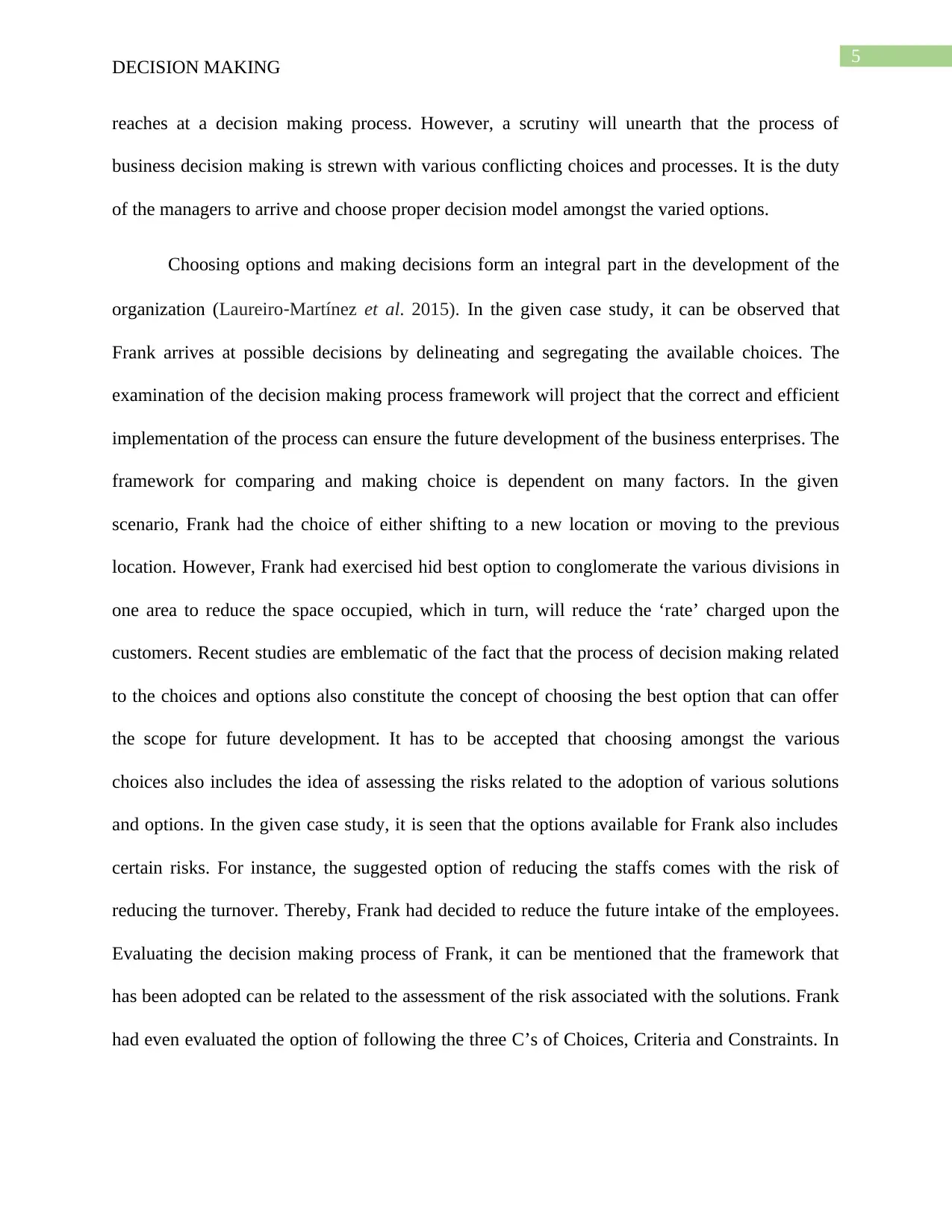
5
DECISION MAKING
reaches at a decision making process. However, a scrutiny will unearth that the process of
business decision making is strewn with various conflicting choices and processes. It is the duty
of the managers to arrive and choose proper decision model amongst the varied options.
Choosing options and making decisions form an integral part in the development of the
organization (Laureiro‐Martínez et al. 2015). In the given case study, it can be observed that
Frank arrives at possible decisions by delineating and segregating the available choices. The
examination of the decision making process framework will project that the correct and efficient
implementation of the process can ensure the future development of the business enterprises. The
framework for comparing and making choice is dependent on many factors. In the given
scenario, Frank had the choice of either shifting to a new location or moving to the previous
location. However, Frank had exercised hid best option to conglomerate the various divisions in
one area to reduce the space occupied, which in turn, will reduce the ‘rate’ charged upon the
customers. Recent studies are emblematic of the fact that the process of decision making related
to the choices and options also constitute the concept of choosing the best option that can offer
the scope for future development. It has to be accepted that choosing amongst the various
choices also includes the idea of assessing the risks related to the adoption of various solutions
and options. In the given case study, it is seen that the options available for Frank also includes
certain risks. For instance, the suggested option of reducing the staffs comes with the risk of
reducing the turnover. Thereby, Frank had decided to reduce the future intake of the employees.
Evaluating the decision making process of Frank, it can be mentioned that the framework that
has been adopted can be related to the assessment of the risk associated with the solutions. Frank
had even evaluated the option of following the three C’s of Choices, Criteria and Constraints. In
DECISION MAKING
reaches at a decision making process. However, a scrutiny will unearth that the process of
business decision making is strewn with various conflicting choices and processes. It is the duty
of the managers to arrive and choose proper decision model amongst the varied options.
Choosing options and making decisions form an integral part in the development of the
organization (Laureiro‐Martínez et al. 2015). In the given case study, it can be observed that
Frank arrives at possible decisions by delineating and segregating the available choices. The
examination of the decision making process framework will project that the correct and efficient
implementation of the process can ensure the future development of the business enterprises. The
framework for comparing and making choice is dependent on many factors. In the given
scenario, Frank had the choice of either shifting to a new location or moving to the previous
location. However, Frank had exercised hid best option to conglomerate the various divisions in
one area to reduce the space occupied, which in turn, will reduce the ‘rate’ charged upon the
customers. Recent studies are emblematic of the fact that the process of decision making related
to the choices and options also constitute the concept of choosing the best option that can offer
the scope for future development. It has to be accepted that choosing amongst the various
choices also includes the idea of assessing the risks related to the adoption of various solutions
and options. In the given case study, it is seen that the options available for Frank also includes
certain risks. For instance, the suggested option of reducing the staffs comes with the risk of
reducing the turnover. Thereby, Frank had decided to reduce the future intake of the employees.
Evaluating the decision making process of Frank, it can be mentioned that the framework that
has been adopted can be related to the assessment of the risk associated with the solutions. Frank
had even evaluated the option of following the three C’s of Choices, Criteria and Constraints. In
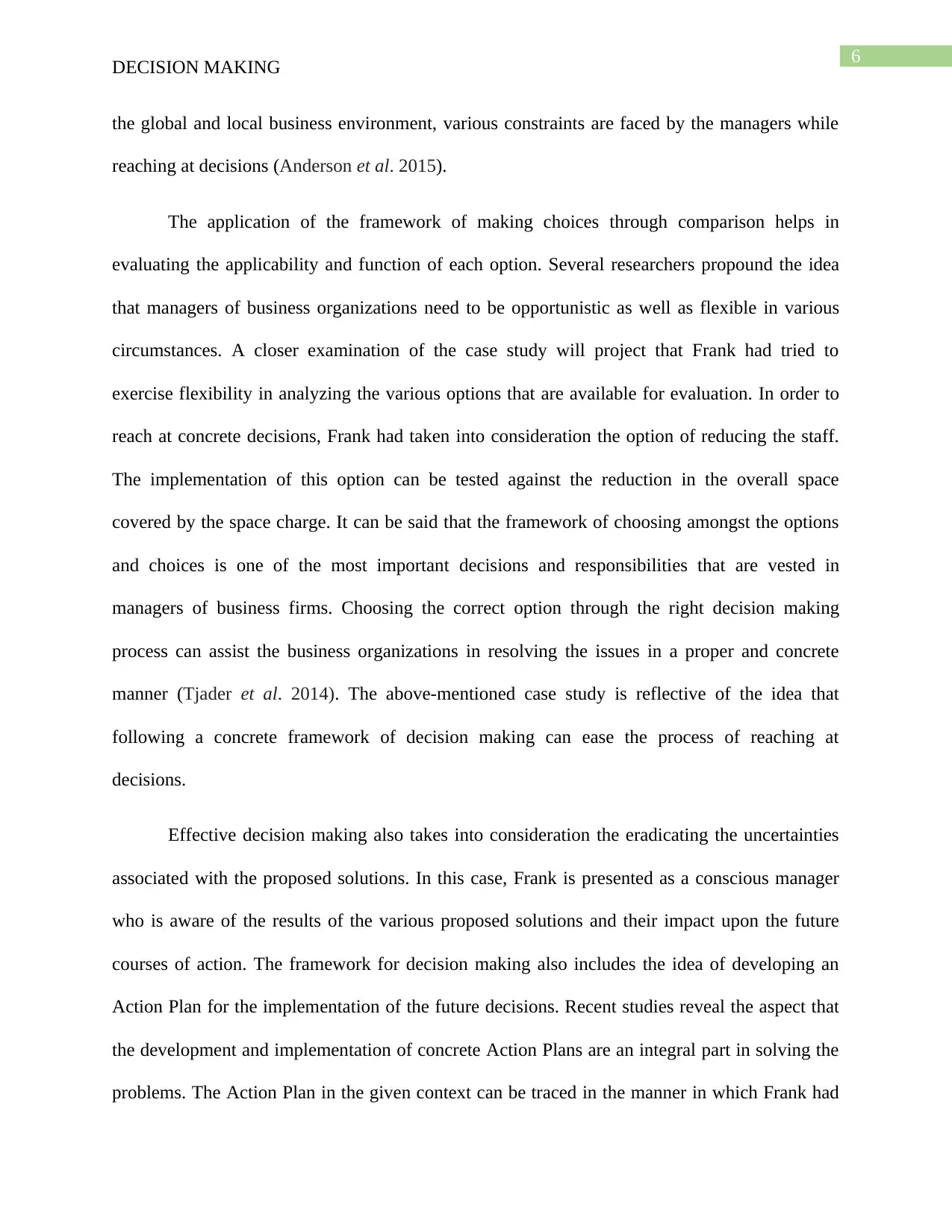
6
DECISION MAKING
the global and local business environment, various constraints are faced by the managers while
reaching at decisions (Anderson et al. 2015).
The application of the framework of making choices through comparison helps in
evaluating the applicability and function of each option. Several researchers propound the idea
that managers of business organizations need to be opportunistic as well as flexible in various
circumstances. A closer examination of the case study will project that Frank had tried to
exercise flexibility in analyzing the various options that are available for evaluation. In order to
reach at concrete decisions, Frank had taken into consideration the option of reducing the staff.
The implementation of this option can be tested against the reduction in the overall space
covered by the space charge. It can be said that the framework of choosing amongst the options
and choices is one of the most important decisions and responsibilities that are vested in
managers of business firms. Choosing the correct option through the right decision making
process can assist the business organizations in resolving the issues in a proper and concrete
manner (Tjader et al. 2014). The above-mentioned case study is reflective of the idea that
following a concrete framework of decision making can ease the process of reaching at
decisions.
Effective decision making also takes into consideration the eradicating the uncertainties
associated with the proposed solutions. In this case, Frank is presented as a conscious manager
who is aware of the results of the various proposed solutions and their impact upon the future
courses of action. The framework for decision making also includes the idea of developing an
Action Plan for the implementation of the future decisions. Recent studies reveal the aspect that
the development and implementation of concrete Action Plans are an integral part in solving the
problems. The Action Plan in the given context can be traced in the manner in which Frank had
DECISION MAKING
the global and local business environment, various constraints are faced by the managers while
reaching at decisions (Anderson et al. 2015).
The application of the framework of making choices through comparison helps in
evaluating the applicability and function of each option. Several researchers propound the idea
that managers of business organizations need to be opportunistic as well as flexible in various
circumstances. A closer examination of the case study will project that Frank had tried to
exercise flexibility in analyzing the various options that are available for evaluation. In order to
reach at concrete decisions, Frank had taken into consideration the option of reducing the staff.
The implementation of this option can be tested against the reduction in the overall space
covered by the space charge. It can be said that the framework of choosing amongst the options
and choices is one of the most important decisions and responsibilities that are vested in
managers of business firms. Choosing the correct option through the right decision making
process can assist the business organizations in resolving the issues in a proper and concrete
manner (Tjader et al. 2014). The above-mentioned case study is reflective of the idea that
following a concrete framework of decision making can ease the process of reaching at
decisions.
Effective decision making also takes into consideration the eradicating the uncertainties
associated with the proposed solutions. In this case, Frank is presented as a conscious manager
who is aware of the results of the various proposed solutions and their impact upon the future
courses of action. The framework for decision making also includes the idea of developing an
Action Plan for the implementation of the future decisions. Recent studies reveal the aspect that
the development and implementation of concrete Action Plans are an integral part in solving the
problems. The Action Plan in the given context can be traced in the manner in which Frank had
Paraphrase This Document
Need a fresh take? Get an instant paraphrase of this document with our AI Paraphraser
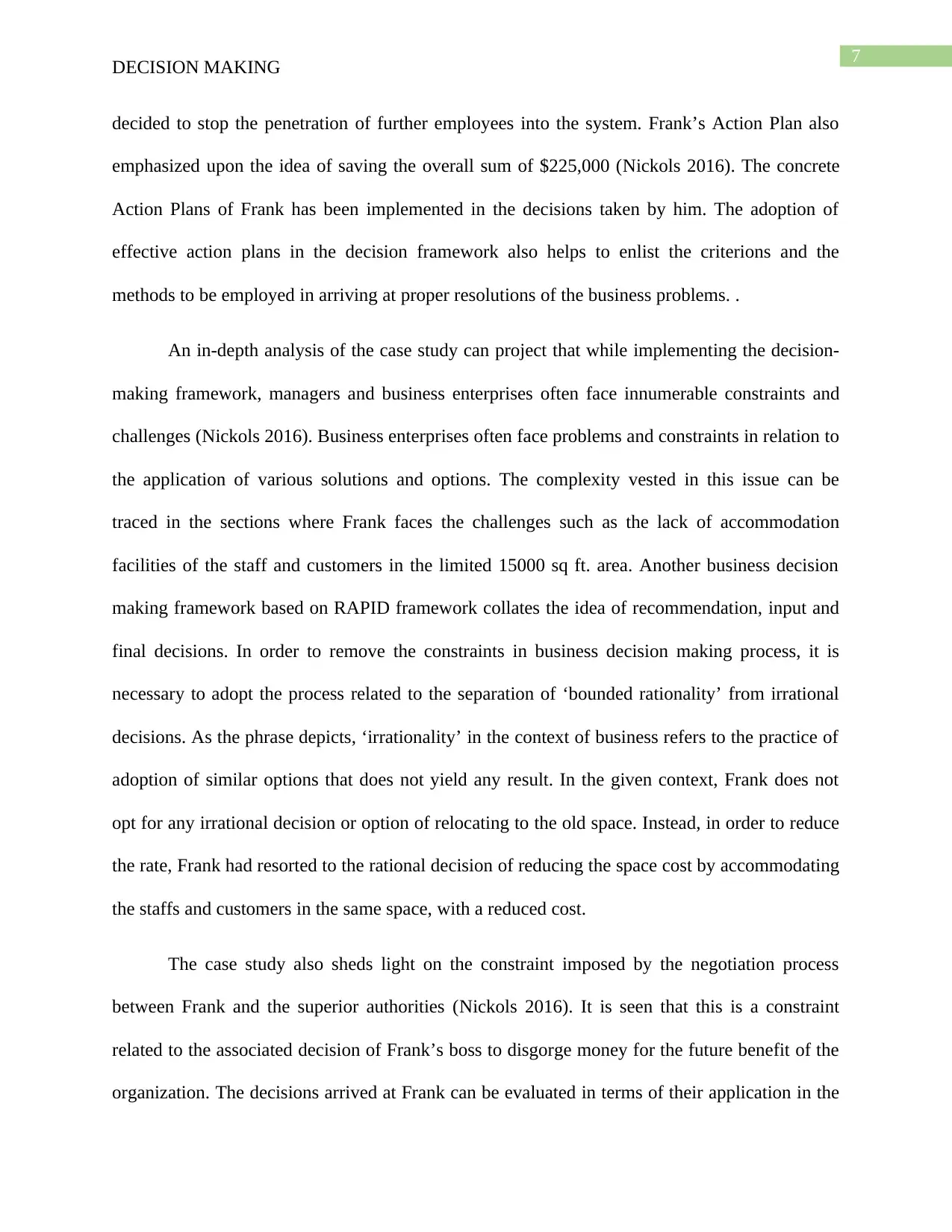
7
DECISION MAKING
decided to stop the penetration of further employees into the system. Frank’s Action Plan also
emphasized upon the idea of saving the overall sum of $225,000 (Nickols 2016). The concrete
Action Plans of Frank has been implemented in the decisions taken by him. The adoption of
effective action plans in the decision framework also helps to enlist the criterions and the
methods to be employed in arriving at proper resolutions of the business problems. .
An in-depth analysis of the case study can project that while implementing the decision-
making framework, managers and business enterprises often face innumerable constraints and
challenges (Nickols 2016). Business enterprises often face problems and constraints in relation to
the application of various solutions and options. The complexity vested in this issue can be
traced in the sections where Frank faces the challenges such as the lack of accommodation
facilities of the staff and customers in the limited 15000 sq ft. area. Another business decision
making framework based on RAPID framework collates the idea of recommendation, input and
final decisions. In order to remove the constraints in business decision making process, it is
necessary to adopt the process related to the separation of ‘bounded rationality’ from irrational
decisions. As the phrase depicts, ‘irrationality’ in the context of business refers to the practice of
adoption of similar options that does not yield any result. In the given context, Frank does not
opt for any irrational decision or option of relocating to the old space. Instead, in order to reduce
the rate, Frank had resorted to the rational decision of reducing the space cost by accommodating
the staffs and customers in the same space, with a reduced cost.
The case study also sheds light on the constraint imposed by the negotiation process
between Frank and the superior authorities (Nickols 2016). It is seen that this is a constraint
related to the associated decision of Frank’s boss to disgorge money for the future benefit of the
organization. The decisions arrived at Frank can be evaluated in terms of their application in the
DECISION MAKING
decided to stop the penetration of further employees into the system. Frank’s Action Plan also
emphasized upon the idea of saving the overall sum of $225,000 (Nickols 2016). The concrete
Action Plans of Frank has been implemented in the decisions taken by him. The adoption of
effective action plans in the decision framework also helps to enlist the criterions and the
methods to be employed in arriving at proper resolutions of the business problems. .
An in-depth analysis of the case study can project that while implementing the decision-
making framework, managers and business enterprises often face innumerable constraints and
challenges (Nickols 2016). Business enterprises often face problems and constraints in relation to
the application of various solutions and options. The complexity vested in this issue can be
traced in the sections where Frank faces the challenges such as the lack of accommodation
facilities of the staff and customers in the limited 15000 sq ft. area. Another business decision
making framework based on RAPID framework collates the idea of recommendation, input and
final decisions. In order to remove the constraints in business decision making process, it is
necessary to adopt the process related to the separation of ‘bounded rationality’ from irrational
decisions. As the phrase depicts, ‘irrationality’ in the context of business refers to the practice of
adoption of similar options that does not yield any result. In the given context, Frank does not
opt for any irrational decision or option of relocating to the old space. Instead, in order to reduce
the rate, Frank had resorted to the rational decision of reducing the space cost by accommodating
the staffs and customers in the same space, with a reduced cost.
The case study also sheds light on the constraint imposed by the negotiation process
between Frank and the superior authorities (Nickols 2016). It is seen that this is a constraint
related to the associated decision of Frank’s boss to disgorge money for the future benefit of the
organization. The decisions arrived at Frank can be evaluated in terms of their application in the
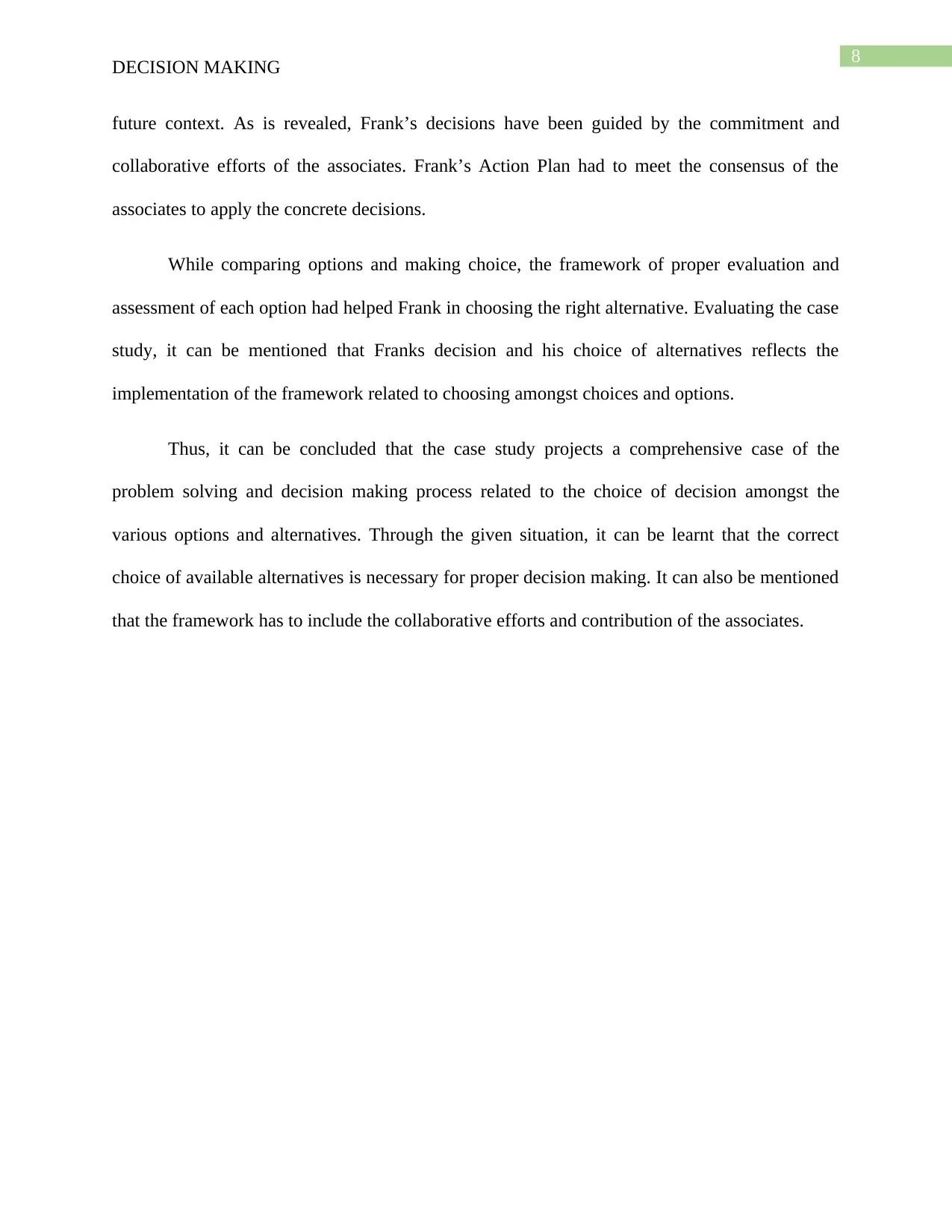
8
DECISION MAKING
future context. As is revealed, Frank’s decisions have been guided by the commitment and
collaborative efforts of the associates. Frank’s Action Plan had to meet the consensus of the
associates to apply the concrete decisions.
While comparing options and making choice, the framework of proper evaluation and
assessment of each option had helped Frank in choosing the right alternative. Evaluating the case
study, it can be mentioned that Franks decision and his choice of alternatives reflects the
implementation of the framework related to choosing amongst choices and options.
Thus, it can be concluded that the case study projects a comprehensive case of the
problem solving and decision making process related to the choice of decision amongst the
various options and alternatives. Through the given situation, it can be learnt that the correct
choice of available alternatives is necessary for proper decision making. It can also be mentioned
that the framework has to include the collaborative efforts and contribution of the associates.
DECISION MAKING
future context. As is revealed, Frank’s decisions have been guided by the commitment and
collaborative efforts of the associates. Frank’s Action Plan had to meet the consensus of the
associates to apply the concrete decisions.
While comparing options and making choice, the framework of proper evaluation and
assessment of each option had helped Frank in choosing the right alternative. Evaluating the case
study, it can be mentioned that Franks decision and his choice of alternatives reflects the
implementation of the framework related to choosing amongst choices and options.
Thus, it can be concluded that the case study projects a comprehensive case of the
problem solving and decision making process related to the choice of decision amongst the
various options and alternatives. Through the given situation, it can be learnt that the correct
choice of available alternatives is necessary for proper decision making. It can also be mentioned
that the framework has to include the collaborative efforts and contribution of the associates.
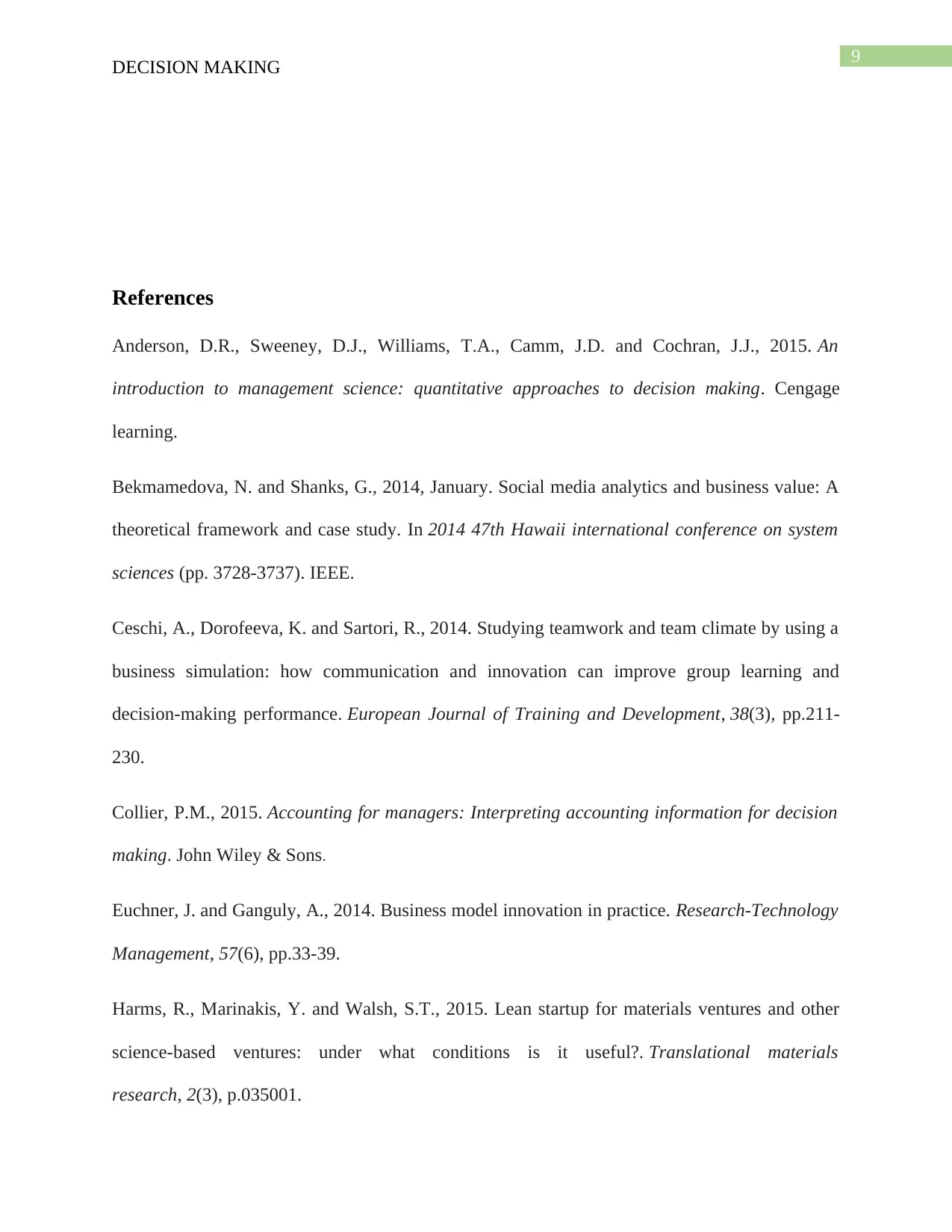
9
DECISION MAKING
References
Anderson, D.R., Sweeney, D.J., Williams, T.A., Camm, J.D. and Cochran, J.J., 2015. An
introduction to management science: quantitative approaches to decision making. Cengage
learning.
Bekmamedova, N. and Shanks, G., 2014, January. Social media analytics and business value: A
theoretical framework and case study. In 2014 47th Hawaii international conference on system
sciences (pp. 3728-3737). IEEE.
Ceschi, A., Dorofeeva, K. and Sartori, R., 2014. Studying teamwork and team climate by using a
business simulation: how communication and innovation can improve group learning and
decision-making performance. European Journal of Training and Development, 38(3), pp.211-
230.
Collier, P.M., 2015. Accounting for managers: Interpreting accounting information for decision
making. John Wiley & Sons.
Euchner, J. and Ganguly, A., 2014. Business model innovation in practice. Research-Technology
Management, 57(6), pp.33-39.
Harms, R., Marinakis, Y. and Walsh, S.T., 2015. Lean startup for materials ventures and other
science-based ventures: under what conditions is it useful?. Translational materials
research, 2(3), p.035001.
DECISION MAKING
References
Anderson, D.R., Sweeney, D.J., Williams, T.A., Camm, J.D. and Cochran, J.J., 2015. An
introduction to management science: quantitative approaches to decision making. Cengage
learning.
Bekmamedova, N. and Shanks, G., 2014, January. Social media analytics and business value: A
theoretical framework and case study. In 2014 47th Hawaii international conference on system
sciences (pp. 3728-3737). IEEE.
Ceschi, A., Dorofeeva, K. and Sartori, R., 2014. Studying teamwork and team climate by using a
business simulation: how communication and innovation can improve group learning and
decision-making performance. European Journal of Training and Development, 38(3), pp.211-
230.
Collier, P.M., 2015. Accounting for managers: Interpreting accounting information for decision
making. John Wiley & Sons.
Euchner, J. and Ganguly, A., 2014. Business model innovation in practice. Research-Technology
Management, 57(6), pp.33-39.
Harms, R., Marinakis, Y. and Walsh, S.T., 2015. Lean startup for materials ventures and other
science-based ventures: under what conditions is it useful?. Translational materials
research, 2(3), p.035001.
Secure Best Marks with AI Grader
Need help grading? Try our AI Grader for instant feedback on your assignments.
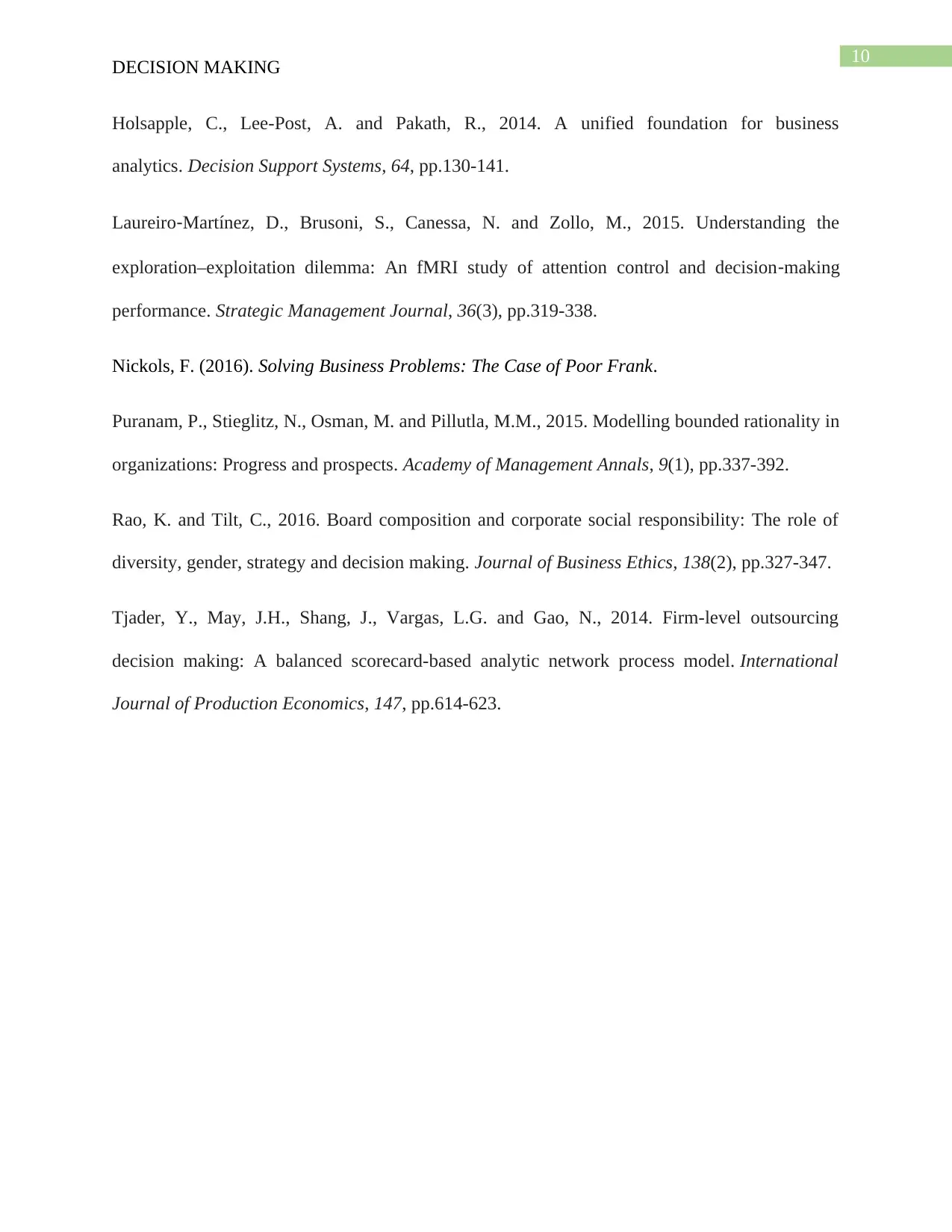
10
DECISION MAKING
Holsapple, C., Lee-Post, A. and Pakath, R., 2014. A unified foundation for business
analytics. Decision Support Systems, 64, pp.130-141.
Laureiro‐Martínez, D., Brusoni, S., Canessa, N. and Zollo, M., 2015. Understanding the
exploration–exploitation dilemma: An fMRI study of attention control and decision‐making
performance. Strategic Management Journal, 36(3), pp.319-338.
Nickols, F. (2016). Solving Business Problems: The Case of Poor Frank.
Puranam, P., Stieglitz, N., Osman, M. and Pillutla, M.M., 2015. Modelling bounded rationality in
organizations: Progress and prospects. Academy of Management Annals, 9(1), pp.337-392.
Rao, K. and Tilt, C., 2016. Board composition and corporate social responsibility: The role of
diversity, gender, strategy and decision making. Journal of Business Ethics, 138(2), pp.327-347.
Tjader, Y., May, J.H., Shang, J., Vargas, L.G. and Gao, N., 2014. Firm-level outsourcing
decision making: A balanced scorecard-based analytic network process model. International
Journal of Production Economics, 147, pp.614-623.
DECISION MAKING
Holsapple, C., Lee-Post, A. and Pakath, R., 2014. A unified foundation for business
analytics. Decision Support Systems, 64, pp.130-141.
Laureiro‐Martínez, D., Brusoni, S., Canessa, N. and Zollo, M., 2015. Understanding the
exploration–exploitation dilemma: An fMRI study of attention control and decision‐making
performance. Strategic Management Journal, 36(3), pp.319-338.
Nickols, F. (2016). Solving Business Problems: The Case of Poor Frank.
Puranam, P., Stieglitz, N., Osman, M. and Pillutla, M.M., 2015. Modelling bounded rationality in
organizations: Progress and prospects. Academy of Management Annals, 9(1), pp.337-392.
Rao, K. and Tilt, C., 2016. Board composition and corporate social responsibility: The role of
diversity, gender, strategy and decision making. Journal of Business Ethics, 138(2), pp.327-347.
Tjader, Y., May, J.H., Shang, J., Vargas, L.G. and Gao, N., 2014. Firm-level outsourcing
decision making: A balanced scorecard-based analytic network process model. International
Journal of Production Economics, 147, pp.614-623.
1 out of 11
Related Documents
Your All-in-One AI-Powered Toolkit for Academic Success.
+13062052269
info@desklib.com
Available 24*7 on WhatsApp / Email
![[object Object]](/_next/static/media/star-bottom.7253800d.svg)
Unlock your academic potential
© 2024 | Zucol Services PVT LTD | All rights reserved.





